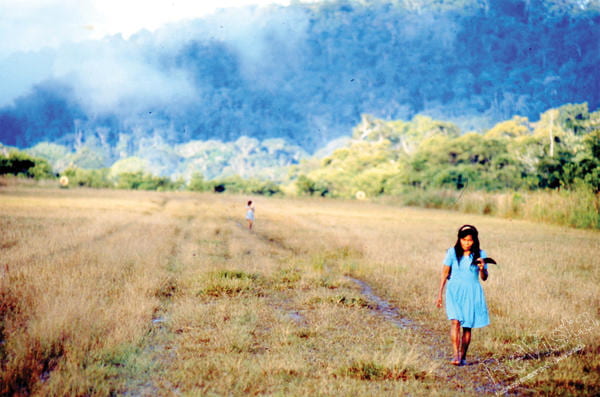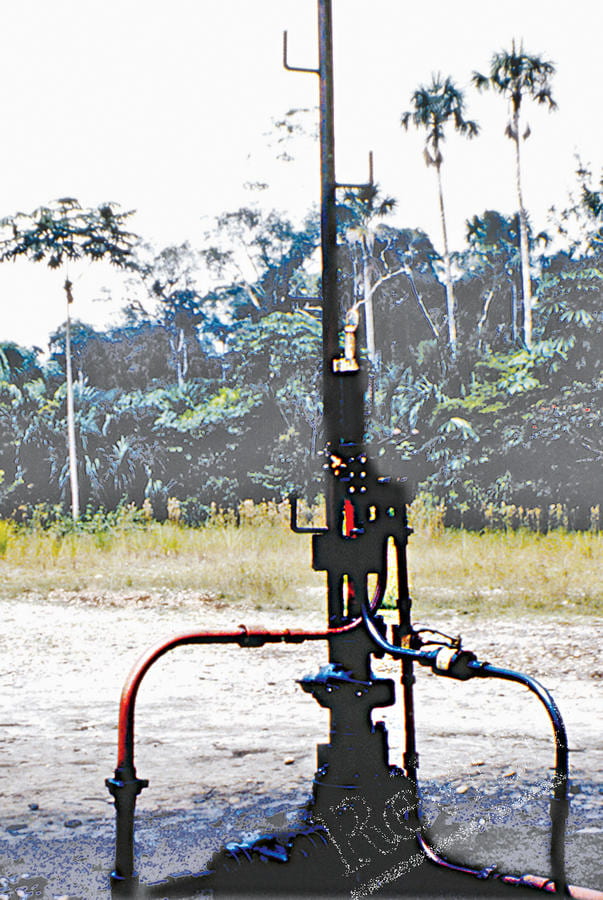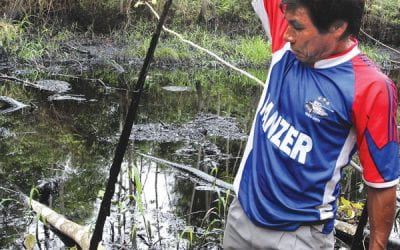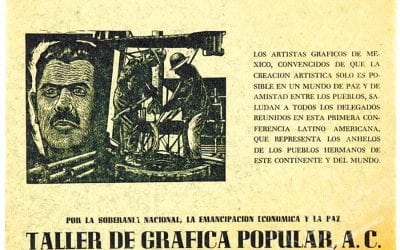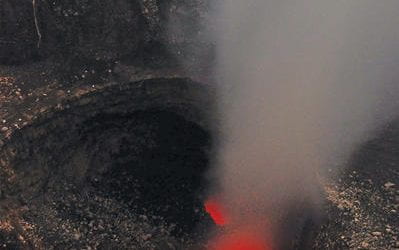Beyond Dinosaurs and Oil Spills
Oil Development and Amazonian Indigenous Peoples
Ecuadoran writer Jaime Galarza’s scathing critique of international oil giants and pliant governments in Latin America in his widely read book, El Festin del Petróleo (1974), helped to win him two years in jail just as Ecuador was opening up its Amazonian region, once again, to oil development. Galarza painted a big-brush picture of rapacious transnational companies in the mid-early 20th century: his Seven Dinosaurs—Standard Oil of New Jersey, Shell, Mobil, Gulf, Texaco, BP, and Standard Oil of California—doing whatever they darn well please in weak countries. Transnational oil companies’ plunders are now tempered by stronger and more democratic governments and the existence of national oil companies across Latin America. While Galarza was later named Ecuador’s first Minister of the Environment, oil development for indigenous communities remains highly controversial and heavily disputed.
Legitimate concerns over spills and other forms of pollution persist. However, a community perspective now encompasses more than concern about the environmental damage wrought by looming international giants and includes national governments and international law. Indigenous peoples have new rights to land, natural resources and citizenship, nationally and internationally. They are also accessing international legal institutions with greater frequency and success. And, though often with great difficulty, they are demanding that their governments not simply ratify international human rights agreements and progressive new laws, but actually implement their associated duties.
LOOKING AROUND: FROM DC-3S TO BELL HELICOPTERS
When Galarza’s book appeared in 1974, I was doing ethnographic research in Arajuno, a Kichwa (Quichua) Indian village located between the Napo and Pastaza rivers of Ecuador’s Upper Amazon. I picked up a copy from the Libri Mundi bookstore in Quito. Though fascinated by Galarza’s anti-imperialist stance, I also hoped to understand why, during the 1940s, Shell Oil had constructed and then abandoned a long, solid and well-drained airstrip in Arajuno, but left little other visible impact and almost no unpleasant memories among the resident Kichwa. In fact, many people enjoyed the short-term jobs. And elders said that since so many young men were busy working for Shell, wild game actually increased. Retired Shell officials in Quito later explained that while some exploring had taken place in Arajuno, the strip, only a 20 minute flight from Shell’s home base in Shell-Mera, was a backup for emergency landings of DC-3s in bad weather. Shell left Ecuador in 1950 without finding marketable oil in this foothills area. And they left no mess, resentment or permanent disruption. But Galarza’s lament about these earlier times (1920s-1950) was hardly the end of the oil story.
By the mid-1970s, oil development was again in, and sometimes on, the air. Several sites that were to become battlegrounds today fanned out to the east of Arajuno. A few years earlier, most of the men of town—like those throughout the Oriente region—were being shuttled about in Bell helicopters as they worked stints for Western Geophysical, cutting paths through much of the northern and central Oriente to permit exploratory seismic studies. In my time (1974-76), and about 100 miles to the northeast, Texaco-Gulf, having finished a massive pipeline to the Pacific coast in 1972, began pumping crude oil out of a growing network of wells between the Aguarico and Napo rivers, connected through an ugly new boom town they named Lago Agrio, close to the rainforest homes to Cofán, Secoya, and, later, Kichwa and Shuar indigenous peoples.
About 150 miles to the southeast, the crackling chatter of Occidental Oil workers frequently overlapped with my daily, two-way radio, weather reports for local bush pilots, telling them whether or not the morning mist had lifted or shifted instead to heavy rain. Occidental Oil was preparing to drill along Peru’s Pastaza, Tigre, and Corrientes rivers, an area now known as Block 1-AB, and home to numerous Achuar, Kichwa and other indigenous peoples.
In mid-1976, two Arajuno Kichwa men, another American and I meandered slowly for about a week by dugout canoe—fishing and hunting and observing—from the headwaters of the Curaray River, through some Huaorani settlements, to the junction of the Villano and Curaray rivers, the site of another Quichua village, Villano. There, suddenly and like some scene from Coppola’s Apocalypse Now, large planes were flying in heavy equipment and men, shattering the quiet as Arco Oil prepared to explore another old Shell site, then named Block 10. At the time, everyone thought all this was quite exciting. That changed.
Now each of these sites casts current oil development disputes into high relief, sometimes produces banner headlines, and draws considerable local anger. In Lago Agrio (Ecuador’s most productive region), a $19 billion suit against Texaco (now owned by Chevron) for pollution near there is world-famous. Those in Villano and their nearby kin-community of Sarayacu are, of course, concerned with pollution. No one wants to live in a polluted and dangerous place like Lago Agrio. Meanwhile, some Kichwa have ratcheted up the debate to engage, indeed challenge, the Ecuadoran government. They are testing Ecuador’s understanding of and compliance with international human rights and national legislation as it applies to oil and other natural resource development. These and other cases and issues were also the subject of multi-party (international oil companies, indigenous leaders and environmental organizations) Harvard Dialogues on Oil in Fragile Environments, which took place at the Weatherhead Center and in Latin America from 1996-2002.
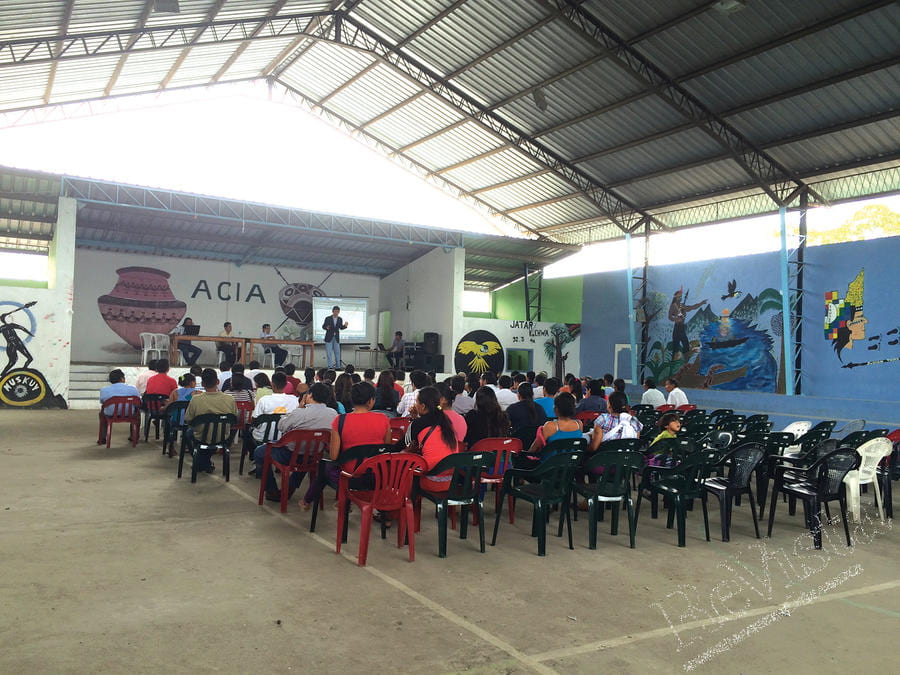
A meeting this summer brought the community together to discuss the new potable water project in Arajuno. ACIA has negotiated that it will not allow oil projects to take place in their communities until the community is provided with potable drinking water. Three years have gone by with no progress, but now it seems that construction of a water treatment plant will begin in March. Photo by Megan Monteleone.
POLLUTION: THE PERSISTENT PROBLEM
Disputes over the mess created around Lago Agrio in Ecuador and other oil sites in Amazonian Latin America have been going on for decades. Pollution has been massive and undeniable. The Texaco case is certainly the best known and currently controversial. In both Ecuador and the United States, numerous legal suits have bounced back and forth since the early 1990s. In 1996, Texaco paid out about $40 million to clean up more than 100 well sites and seven spills, a remediation that it was supposed to share with its national oil company partner, Petroecuador. Although the work, coordinated by Petroecuador, now the sole owner of the plots, won Texaco releases from communities and organizations, many areas remain severely polluted and unhealthy. Current efforts to revisit the case by suing the new owner of Texaco, Chevron, and truly remediating the sites and communities where Petroecuador is the sole owner remain quite contentious. In a high-level battle now characterized more by large egos than environmental or social concerns, ambitious Chevron executives take on controversial class-action lawyers, an evasive national oil company, and questionable Ecuadoran legal procedures and judges, with no likely settlement or clean-up on the horizon, leaving lots of hopeless, angry, abandoned, and impoverished people in northern Ecuador. (See Paul M. Barrett’s excellent recent account, Law of the Jungle.)
By contrast, in Peru, after a series of similar complaints regarding that country’s largest production area, the government declared Lot 1-AB to be an “environmental disaster,” complicating current desires to renew contracts. The area’s original single operator, Occidental, has worked to repair environmental damages, reaching an “out-of-court” settlement to provide funds to local communities. Nevertheless, Block 1-AB—now a patchwork of operators including Occidental, Pluspetrol, Burlington, Repsol, China National and others—recently suffered a large rupture in its 39-year old pipeline, and a large area awaits cleanup.
None of this is new, or surprising. In addition to breaks and spillage along pipeline routes, toxic waste, which, by law even in the “old days” should have been reinjected into the well, was dumped into unlined pits. From there pollutants flowed into rivers during heavy rains or simply escaped when the dirt walls eroded. And in Ecuador, crude oil was even thrown onto the roads in dry weather to keep down the dust.
All of this early work produced ugly landscapes—large sections of denuded tropical rain forest, severely polluted rivers, and sickened human populations. No one denies it. Numerous observers, journalists, independent scientists, and even government agencies and the oil companies have documented the northern Ecuadoran Oriente.
Both the Lago Agrio and Block 1-AB cases focus on cleanup. Current and carefully monitored technical regulations suggest that nothing resembling the neglectful messes left by Occidental and Texaco in northern Peru and Ecuador will be repeated. The ARCO Villano case now illustrates some of the recent technical advances. In Block 10, ARCO, in addition to controlling toxic wastes, set new environmental standards by constructing a road-free well site and laying pipeline in the rainforest. The company followed the model of an offshore rig, where equipment and men are ferried in by air, and pipelines are laid by helicopters hovering atop narrow cuts in the forest. This minimized damage to the forest and avoided the sorts of invasive roads that easily and quickly become troublesome vectors for colonization, logging and other incursions into indigenous territories. The same sorts of technologies are being used in Peru’s huge Camisea Gas project and many other rainforest sites.
In reviewing this innovative project at the Harvard Oil Dialogues in 1997, the general manager of ARCO-Ecuador commented to NRDC and The Nature Conservancy:
“What will you guys say when we can get oil out of the ground by osmosis?”
Many smiled and nodded their heads. However, for the indigenous participants at the Dialogues, vexing social and political questions, and the neglected responsibilities of the government, outweighed discussions of spills and other environmental questions. Two of the major and persistent concerns—consultation with affected communities and respect for indigenous organizations—are illustrated by situations that developed in and around the ARCO sites at Villano and nearby Sarayacu.

Opening rain forest roads for oil pipelines and timber extraction, and avenues for colonization. Photo by Theodore Macdonald.
FROM POLLUTION TO PARTICIPATION: WHERE’S THE STATE?
In mid-1989, while I was sitting one afternoon with members of FOIN (Napo River’s regional ethic federation), leaders of this as well as the national indigenous organization (CONIAE) rushed in to announce their departure for Sarayacu. An extraordinary drama of land and natural resource rights was unfolding. Earlier, contractors exploring ARCOs’ Block 10 had been ejected by Sarayacu community members, who argued that the workers were exploring illegally within their territory without prior consultation. Oil company and government officials flew to Sarayacu’s small jungle airstrip. Community members welcomed the meeting but immediately placed logs on the airstrip, preventing the officials from departing. They also invited leaders of other indigenous organizations, who, for several years, had also been petitioning the government for recognition of broad ethnic territories. The “meetings” lasted 12 days, during which some government officials became ill (indigestion, it was reported), while in Quito some, including President Rodrigo Borja, trumpeted the incident as a “kidnapping in the jungle,” despite Sarayacu’s statement that the officials were free to walk out at any time (a long walk). Given the often voiced government claim that Ecuador was a “multicultural nation,” this tense symbolic national drama drew no military response, despite the close proximity of a large Ecuadoran army base in Shell-Mera. Instead the officials and community leaders jointly drafted the Sarayacu Accords, which, along with significant restrictions on regional oil development, promised to demarcate and title indigenous territories. Secure land rights would promote a unified territory and solid base from which OPIP, the umbrella indigenous association, could negotiate any future oil development and regional planning. The idea was, of course, to prevent repetition of the environmental mess to the north, but more important, to replace small community development projects and individual handouts with integrated pan-territorial development planning, utilizing a significant share of the region’s oil revenues.
However, over the next couple of years the Sarayacu Accords languished. Meanwhile ARCO was negotiating access and providing modest local economic support to the small communities closest to its anticipated well site. This flew in the face of OPIP’s broader demands. So, in July 1992, OPIP staged a spectacular and highly publicized, 500-kilometer, 2,000- person March from the Amazon city of Puyo to Quito, the capital. Shortly thereafter, President Rodrigo Borja’s government titled significant amounts of indigenous lands. However, this was awarded not as the single indigenous territory envisioned by OPIP, but rather through a series of irregular blocks in Pastaza Province. The government thus rejected OPIP’s demands for a broad participatory development program while continuing to press ARCO to meet its obligations to provide for communities’ basic needs and services.
While ARCO easily contracted community relations specialists, the private company would never be in a position to design and implement, let alone allocate sufficient resources for, a regional development program that would extend far beyond its narrowly defined work area.
The government thus determined control over lands and defined the duties of the companies. So the public debate continued, with ARCO arguing that the company was obliged only to help those communities directly affected by its work; and ARCO continued this policy even though it led to fierce factional disputes within the communities and, at one point, sparked a short-term kidnapping of the ARCO community relations manager in one of the Villano communities. OPIP and its NGO supporters, meanwhile, responded that any development should be a broader ethnic “territorial” matter, and argued that the company was seeking to weaken OPIP by pitting the communities against one another.
Each had a point. Yet, several years later, at the Harvard Dialogues, both ARCO and OPIP representatives expressed frustration with the absence of the government in areas where, they argued, policy decisions and provision of basis services were its responsibility. OPIP interestingly added that earlier governments consistently relied on foreign missionaries to provide basic health and education to isolated indigenous communities. Now it was oil companies.
OPIP continued to draw national and international supporters for its legitimate demands. This led to OPIP’s inclusion in a multi-party commission convened to discuss the project’s progress. In 1999, oil began to flow uninterrupted out of Pastaza Province from ARCO’s environmentally pioneering and road-free well site and pipeline. And OPIP was not managing regional planning.
At the time (early-to-mid 1990s) this highly publicized dispute was largely, and unfortunately, a matter of words, recriminations, charges and counter-charges between relative unequals. Respect for indigenous territories and organizations was largely a matter of choice and relative power, which favored the government and the oil company. Many, of course, supported the underdog OPIP, but it seemed that traditional sources of power and wealth once again predominated. Fortunately, that was not the end of the matter.
SARAYACU AND INTERNATIONAL PROTECTIONS
ARCO did not return to neighboring Sarayacu after 1989. But in 1996, after land titling reshaped the provincial map, an Argentine oil company, CDG, signed an agreement with Ecuador to explore and develop Block 23, a concession which, as with ARCO’s earlier, overlapped with Sarayacu’s territory. And once again the community said no, refusing to permit contractors to gather data for the essential Environmental Impact Assessment. Sarayacu in many ways was the same story with the same actors as Villano—an oil international company (CDG), indigenous communities and regional federations, government support for CDG, and international NGO support for the indigenous communities. But after the mid-1990s, the nature of the debate shifted and altered the earlier power imbalance.
In May 1998, Ecuador ratified ILO Convention No 169. The international treaty went into force in May 1999, and Ecuador’s 1998 Constitution incorporated many of the same rights. Consequently, though Sarayacu’s community persistence, CDG’s responses, and government actions produced many of the same sorts of petty intrigues, rumors, accusations, counter-accusations, demonstrations, insinuations and factions that surrounded the Villano case, outcomes were different.
No longer were terms like “territory,” “development” and “organizations” simply part of an indigenous vocabulary thrown into the soup of a debate. International conventions and national legislation clearly stated that indigenous territories must be respected, natural resource development must not harm and in fact must benefit affected communities, and any related negotiations must respect the authority of indigenous organizations.
But a common legal argument soon developed. Because CDG had received the concession before the ILO Convention was ratified and before Ecuador’s new Constitution took over, the company argued that the new laws should not be applicable retroactively. But earlier community opposition had prevented completion of the required environmental studies, so exploratory activities were, in fact, suspended until 2002. Despite divisive activities that created individual community agreements and spontaneous settlements, pitting communities against each other, Ecuador passed a series of laws requiring consultation with the communities, and creating mechanisms to enforce them. But as debates swirled and government agencies competed with (or at least contradicted) one another over interpretation and implementation, CDG, beginning in 2002, advanced its seismic studies and placed explosives in the ground. Sarayacu blocked further advances and led the company to declare “force majeure” and stop working. But the explosives remained in the ground. Eventually, the Ecuadoran government, frustrated and angry with Sarayacu, used violence (military and police) and intimidation. And, as inter-community tensions rose, police failed to protect Sarayacu citizens passing through adjacent communities.
The aggressive violence elevated Sarayacu’s claims from civil disputes to criminal actions. This won international NGO support for the community. But, decisively important, the violent actions and legal inactions drew the attention of the Inter-American Commission on Human Rights, where a complaint was lodged and accepted. Subsequently, the Commission granted “precautionary measures” to require the removal of explosives, and recommended movement towards some mutually acceptable agreement on the entire dispute.
Meanwhile, and directly related to the community’s original concerns, two judgments by the Inter-American Court of Human Right on the land rights and consultation in indigenous communities of Awas Tingni (vs. Nicaragua, 2001) and Saramarka (vs. Surinam, 2007) produced critical precedents regarding indigenous territories as “property” and requiring “consultation” with regard to all phases of development affecting indigenous lands and communities.
The oil company (CDG) clearly had not respected those rights. In November 2010, the Ecuadoran state petroleum company, Petroecuador, terminated CDG’s contract. Some suggested that this was a “victory” for Sarayacu. The transnational company was gone. However, Ecuador’s decision to terminate CDG’s contract was based a number of other interests. More important, Block 23 would simply come up for bids again when a new round of offering took place in the future. And concerns had shifted to the government.
With the new legal precedents, and the Ecuadorian government’s persistently tense relations with Sarayacu, in 2011 the Inter-American Commission elevated the Sarayacu case to the Inter-American Court on Human Rights. In its 2012, 90-page decision, the court concluded, of course, that the violence was unacceptable and that the explosives must be removed from the territory. But the bulk of the decision focused on Ecuador’s failure to respect the property rights of, and to properly consult with, community members in the development plans. The court explained, in great detail, why such actions were no longer acceptable or legal in Ecuador or across Latin America. Any subsequent oil development on Block 23 would have to recognize community property and include community members in all activities.
The case demonstrates that—in Sarayacu and across Ecuador and other Latin America landscapes—disputes over natural resource development have now shifted from a nearly exclusive focus on the dangers of large international companies to the duties of the state. While Galarza’s “Seven Dinosaurs” now have the UN-defined responsibility to respect human rights, most corporate responses to complaints and efforts at remediation, however satisfactory, will probably remain voluntary. Complaints and suits will probably be resolved out of court, as illustrated by the current Texaco/Chevron in Ecuador and Occidental in Peru. Such outcomes are largely matters of good will and private decisions, which do little to alter the traditional power asymmetries. States, by contrast, now have the formal legal obligations and duties to respect the human rights of indigenous peoples. Drawing on the ILO convention and UN Declaration, as well as Peru’s and Ecuador’s new constitutions, indigenous peoples now have legal frames, mechanisms, and precedents through which to argue and advance inevitable local disputes and claims with regard to natural resource development.
CAUTION NONETHELESS
These well-known cases, which are often clouded by explanatory global tropes that have shifted from Imperialism and Colonialism to Neoliberalism and Foucauldian Power (all minimizing human agency), illustrate significant advances enabled by international human rights. Though they cannot be expected to spark instant social or economic equality, the new human rights laws, seen from the perspective of those who benefit most from them, offer the possibility of long-term changes in historically imbalanced settings. The new power of human rights, however, should not be overemphasized. Though a shift is underway, ex-UN Special Rapporteur James Anaya has stressed that large gaps remain between recent and impressive indigenous rights legislation and broad realization of those rights, particularly as they relate to land and natural resources. But the contrast between what went on in Villano and Sarayacu, and how communities approached remedies, suggests not only that recent legal advances make a difference, but that this change may be structural and permanent, grounded in law rather than on caprice or contingency. While technical advances and environmental regulations have not tabled concerns over pollution and spills, invoking their harm is not the main concern of indigenous peoples today in Latin America. Nor, it now seems clear, was it when these cases first emerged.
None of these communities and organizations is inherently opposed to natural resource development. But most will argue against the manner in which it is generally undertaken; that is, without proper local participation and consultation. The danger of such neglect and exclusion was clearly illustrated six years ago this summer, when violence and deaths shook the oil region near Bagua, Peru. The major challenge of the early 21st century is the failure to bridge the easily avoided gaps between progressive legislation and insensitive actions that most indigenous peoples see as the main problem, as a glance at the Latin American indigenous news webpage Servindi illustrates almost daily.
Bringing this story full circle, in early June 2015, the indigenous organization Acia Arajuno, non-existent when I lived there, responded to renewed interest in oil development around nearby Rucullacta, and rumors abounded that oil company’s helicopters would soon be hovering overhead. The indigenous assembly proclaimed its opposition, not because of any anticipated mess, but because they had not yet been informed or consulted. And, the leaders added, before any government officials showed up to discuss any possibility of oil development, the government had to fulfill its basic duty and its delayed promise to provide Arajuno with potable water.
Fall 2015, Volume XV, Number 1
Theodore Macdonald is a Lecturer in Social Studies and a Faculty Affiliate at DRCLAS, Harvard University. From 1996 to 2002, he co-directed the Harvard Dialogues on Oil in Fragile Environments.
Related Articles
Oil and Indigenous Communities
On a drizzly morning in late February, a boat full of silent Kukama men motored slowly into the flooded forest off the Marañón River in northern Peru. Cutting the…
Mexico’s Energy Reform
The small, white-washed classroom at the University in Minatitlán, Veracruz, was packed with a couple dozen people who, although neighbors, had never met…
Geothermal Energy in Central America
When we think about global technology leaders, Central America does not typically come to mind. But Central American countries have indeed been in the…

